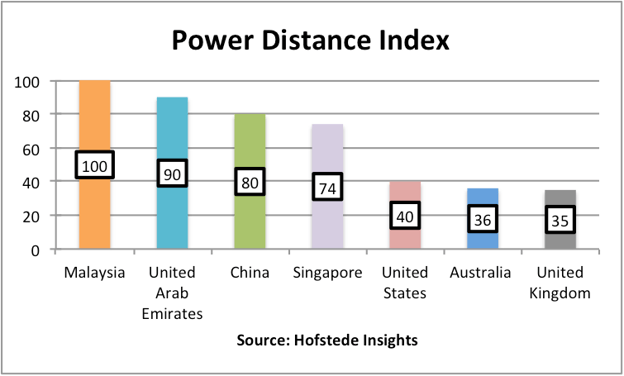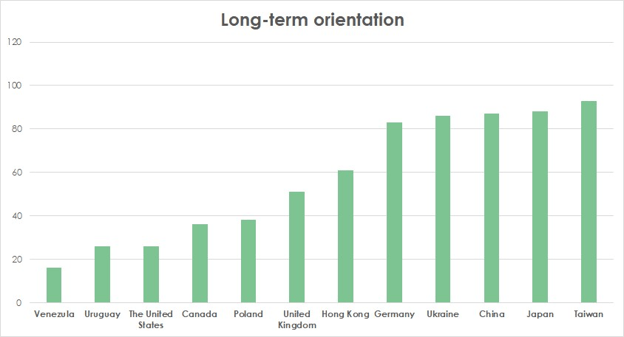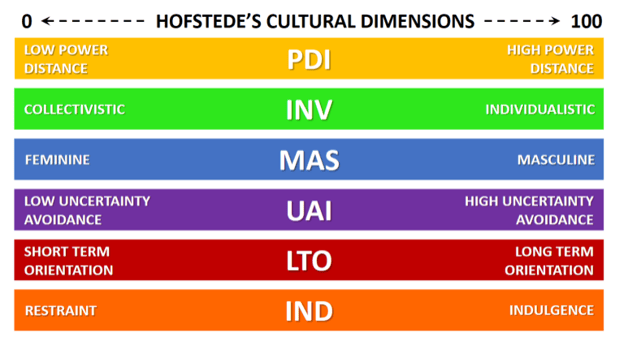Align Your Team with the Hofstede Model of Organizational Culture
Gain an in-depth understanding of the six cultural dimensions that shape company climate, and learn how to harness them for greater performance.
Picture this: it’s your first day at a new job in a country you just moved to. You’ve researched everything you could think of about the company, and already had an introduction call with the team you’re joining. It feels like a good fit, and you are eager to get started.
In your previous company, small talk was common before a big meeting. Everyone would lighten the mood by sharing little stories about what happened over the weekend. However, this new atmosphere feels more formal — the colleague who organized the meeting wastes no time getting straight to the point.
Although you were aware of certain national and cultural differences, you are surprised by the abruptness, and worry that this is just the tip of the iceberg. You begin to look towards learning more about the company’s organizational culture.
There are many models you can look to if you want to better understand this topic. And today we will be looking at one that can be especially helpful: the Hofstede model of organizational culture, which has been used for decades throughout the business world to help define and align a company’s culture and climate.
In this article, we will explore:
- Why organizational culture matters
- How Hofstede’s six-dimensional model was developed, and what it tells us about organizational culture
- How you can use Hofstede’s six dimensions to improve your company’s communication, collaboration, and more

What is organizational culture, and why does it matter?
Before we dive into Hofstede’s model of organizational culture, let’s start with some definitions. At its core, organizational culture can be summed up as behavior that is accepted as normal within a group.
Ultimately, company culture is shaped by the individuals who work there and is a reflection of employees’ relationship with their work, their colleagues, themselves, and the world around them. Culture is a foundational experience, meaning we carry it with us even when we’re not working, which is why cultivating a positive organizational culture is so important.
The Society for Human Resource Management conducted a Global Culture Research Report, and the results confirmed the power of positive organizational culture. 90% of employees who said their culture was “poor” were thinking about quitting, compared to 32% of employees who rated their culture as “good.”
By changing the way we interact and connect at work, the pandemic has made company culture more important than ever before, with companies putting an emphasis on fostering positive workplace cultures coming out on top.
A 2021 PwC study showed that 69% of corporations that managed to adapt during the pandemic say their culture gave them a competitive advantage.
Across the board, a strong workplace culture offers many benefits, including:
- Improving communication between stakeholders
- Uniting employees through shared values
- Making team members feel supported in achieving goals
- Helping retain and attract workers
While there are many different types of organizational cultures, pinpointing the most beneficial kind for your organization, and taking on the hard work of transforming it, first requires a deep understanding of the different aspects at play within your organization.
This is where the Hofstede dimension-based model can be a helpful guide to making strategic decisions that are aligned with the values your company stands for.
Hofstede’s model of organizational culture
Geert Hofstede was a Dutch social psychologist and anthropologist who was considered a pioneer in the field of cross-cultural management and organizational behavior research, helping shape the world’s understanding of how cultural values influence the way individuals behave and interact within organizations.
Hofstede viewed culture as a shared experience where group members learn how to behave from one another. As he saw it, a person’s influences stem from the environments they’ve navigated since childhood. He believed that, at our core, we keep the values that make us who we are, however, we change our outer layers to fit in with whatever group or organization we join.
Hofstede’s formative work came in the 1960s and 70s when he was working at IBM. Frustrated by how aspects of culture were typically defined by socio-economic factors (i.e., modernity vs tradition) he decided to conduct a study with employees across 70 countries to identify differences in cultural values and attitudes.
Another international survey enabled him to confirm his theories and identify six dimensions of cultural differences – showing how the rituals and traditions we absorb through our national cultures also have a big impact on how we act within an organization.
Hofstede's six dimensions of organizational culture
Hofstede’s six dimensions of organizational culture are usually measured on a scale from 0 to 100, with a higher score indicating a stronger presence of that dimension in the culture being measured.
- Power distance measures the degree of separation between managers and their lower-ranking employees within a hierarchy.
High power distance cultures are characterized by obedience, interdependence, and a top-to-bottom information flow, while low power distance cultures are more cooperative, independent, and share knowledge and ideas more freely across the organization. In Mexico, power distance is high which indicates that people are generally more comfortable with an unequal distribution of power, while in Sweden, where power distance is low, a more egalitarian approach is the preferred way of operating.

Hofstede’s power distance dimension of culture in different countries
- Uncertainty avoidance refers to a culture’s level of tolerance for change or uncertain future scenarios.
In high uncertainty avoidance cultures, there’s a tendency for restraint and order. Greece and Belgium score high on this scale. By contrast, low uncertainty avoidance cultures appreciate taking risks and improvisation. Denmark is a good example of this. With a score of 36, it shows they are comfortable with change and the unknown.
- Individualism vs collectivism illustrates whether individuals in a culture tend to think more of their own goals and desires or those of the group.
This dimension of Hofstede organizational culture highlights, among others, the difference between Eastern and Western cultures. Countries like the US and the Netherlands generally value individual performance and caring for themselves and their immediate family, while in Japan and China, a collective approach is the norm – team members think of their team’s interests before their own.
- Masculinity vs femininity represents the extent to which a culture favors traditionally masculine or feminine traits. Although the lines have blurred in recent years, widespread culture change is slow, making this dimension still relevant.
Masculine cultures, such as Italy and Switzerland, are more assertive, goal-oriented, and competitive. On the other end of the spectrum, Norway and Sweden represent feminine cultures, more often valuing intuition, harmony, and win-win situations.
- Long-term vs short-term orientation indicates whether a culture cares more about the present or the future.
Short-term-oriented cultures tend to immerse themselves more in the present moment, love to be of service to others, and often indulge in over-consumption. They’re prevalent throughout South and North America. Long-term-oriented cultures think more about the future and value perseverance and prudence over momentary gratification. Two examples are Japan and Taiwan.

The Hofstede long-term orientation dimension in different countries
- Indulgence vs restraint refers to how much individuals allow themselves enjoyment and the fulfillment of personal desires.
Indulgent cultures focus on positive emotions and personal freedom while restrained cultures more often control their desires, valuing orderliness and hard work over leisure. Eastern European and Asian countries are usually more restrained cultures, whereas indulgence prevails in the Americas and Western Europe.
How to determine your organization’s cultural dimensions
Now that you have an understanding of Hofstede’s six dimensions, it’s time to examine the dimensions of your organization. Keep in mind that although we study them one at a time, the six dimensions are interconnected.
To start, ask yourself these questions to assess where you fall on each dimension:
-
Power distance: How freely does information flow between team members and management?
- Uncertainty avoidance: How does our organization approach risk-taking and spontaneity?
- Individualism vs collectivism: In what ways do team members support each other? How does our organization define achievement?
- Masculinity vs femininity: What words characterize our company’s communication style between team members and clients?
- Long-term vs short-term orientation: How does our organizational strategy and planning prepare us for the next 5-10 years? How does it prepare us for the next 20-30 years?
- Indulgence vs restraint: What rituals do we have in place to celebrate and recognize the various stages of our growth as professionals (from the daily wins to the big successes)?
Once you understand your company’s dimensions, you can begin to harness them to:
- Better understand cultural differences
- Improve communication and management practices
- Develop culturally sensitive strategies to service your market
If your responses seem to fall on one side of the spectrum for a particular dimension, what would happen if you tried embracing some aspects from the opposite end?
For example, if your company tends to value the collective over the individual, maybe you can start the next team meeting by praising colleagues who finished challenging projects. In turn, those individuals can share who helped them the most on their projects. This could foster a sense of connection and gratitude, especially helpful if employee satisfaction ratings are low.
The key is to identify the cultural dimensions you might want to change, and then find actions you can take that will support that cultural change.
How leaders can set the cultural tone
Although individual team members have the power to shape culture, taking action to change cultural dimensions starts at the very top. One study found that 83% of employees believe their leaders and managers have the strongest influence on the overall culture.
Yet, while leaders have the most influence over a company’s climate and culture, one study from Deloitte found that a whopping 72% of executives don’t know their culture at all. That’s why tools like Hofstede’s cultural dimensions are so important. Alongside regular check-ins with employees, surveys, KPIs, and other indicators, leaders can assess the overall health and stability of their organization and train themselves to adopt the growth mindset needed to shift the cultural tides in the right direction.
To become aware of our behavior as leaders, we first have to look to our mindset. By checking in with ourselves, we gain insights that will help us set the cultural tone our team or organization needs. Ready to lead by example? Discover tools to help you manage your mindset and guide your team effectively.
Conclusion
Organizational culture is shaped by many external and internal factors. Though some – like the wider culture – aren’t always within our control, organizations can use Hofstede’s six cultural dimensions to understand the current climate. Strong leadership is then the wind that takes the organization where it wants to go.
Or curious to learn how to encourage self-development and continuous improvement in your teams? Download our workbook Praise the Effort by clicking the banner.



